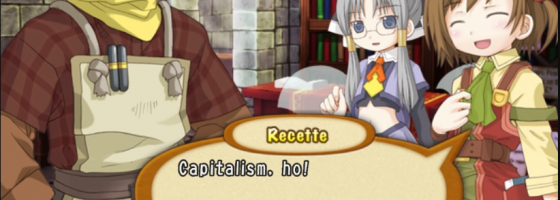It has been eight years (more if we count the Japanese release) since Recettear was released in the United States and the first game localized by studio Carpe Fulgur. Similar to titles like Harvest Moon and Animal Crossing, the charming combination of genres became a cult hit. As of last year, the game sold around 500,000 copies, and there have been many imitators and attempts to outdo it. Yet despite the many indie games that have, Recettear still remains the top, and we’re going to take a closer look at shop simulators to find out why.
Capitalism Ho:
Recettear’s gameplay loop is split between two systems. You have the shop management side which is where you buy and sell items, and then you have the dungeon crawling or combat. Both systems rely on the other in order for the player to progress.
By selling items in the shop, you’ll earn money that will keep your shop open, and you can outfit your adventurers for free. Going into the dungeons will progress the story and earn you items that you could take back to sell at your shop. By selling items at a fair price, you raise your merchant level which unlocks additional features and is required to see everything.
With Recettear, the dungeons themselves were the progression gate to finding new and better items. You would find items that you could try to outfit your adventurers with, or sell for money to pay your rent at the end of each billing cycle.
Recettear is a clear example of the adage: Greater than the sum of its parts, and how both systems worked in unison to be effective.
Swords and Stores:
When it comes to other indie developers who have tried their hand at this formula, they tend to mess up by focusing on one of the two systems. With the game Moonlighter, the design has a heavy emphasis on the combat side, but very little progression or depth on the shop. In fact, the shop can only be upgraded after making progress in the dungeon.
Other designs I’ve seen put all the focus on the shop side, and leave the combat very simplistic (or not at all as we’ll talk about next). In order for the design to work, both systems have to be given attention and work towards progress in the game.
It’s very simple to design one of these games where the focus is all on one of the two systems, but it’s a different matter when both have their own focus.
Idle Shopping:
The other point I want to discuss is the other end of spectrum. Many Indie shop simulator games have tried to approach things by focusing entirely on the sim aspect. In these titles, the player has a lot of ways to create items and run their shops. A popular sub genre of the shop sim is letting players run a blacksmith or some kind of an artisan store.
While these games have good systems to them, they’re missing half the equation due to not having any real combat system. Many of the games I’ve played either abstract combat to something off screen, or let the player watch, but have no real control over what happens. In these cases, progression is entirely defined by the gear you’ve created or bought, but without player input.
In this way, these games are more along the lines of idle design; where you will build something and then wait for a timer to end before you can move forward. You still have materials and progression gated by combat, but without having an actual gameplay system, the experience feels hollow. The key element of the gameplay loops is that what you do in one system will impact your options in the other.
Taking Over the Market:
At this time, despite playing so many shop simulator games on Steam and mobile, none have managed to get the combination of sim and combat down like Recettear. The mix of genres looks easy on paper, but any kind of multi-system design takes time and effort to do it justice.
What are your favorite examples of shop simulator games, and if you’re working on one that you would like me to look at, please get in touch.



